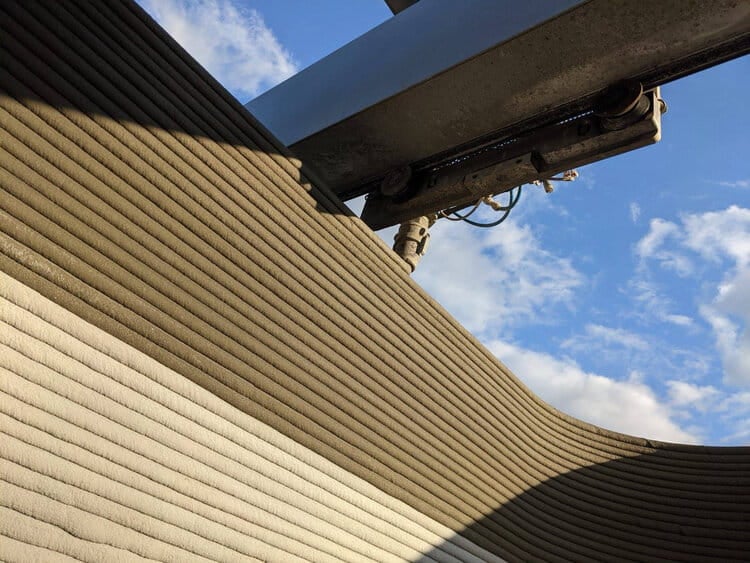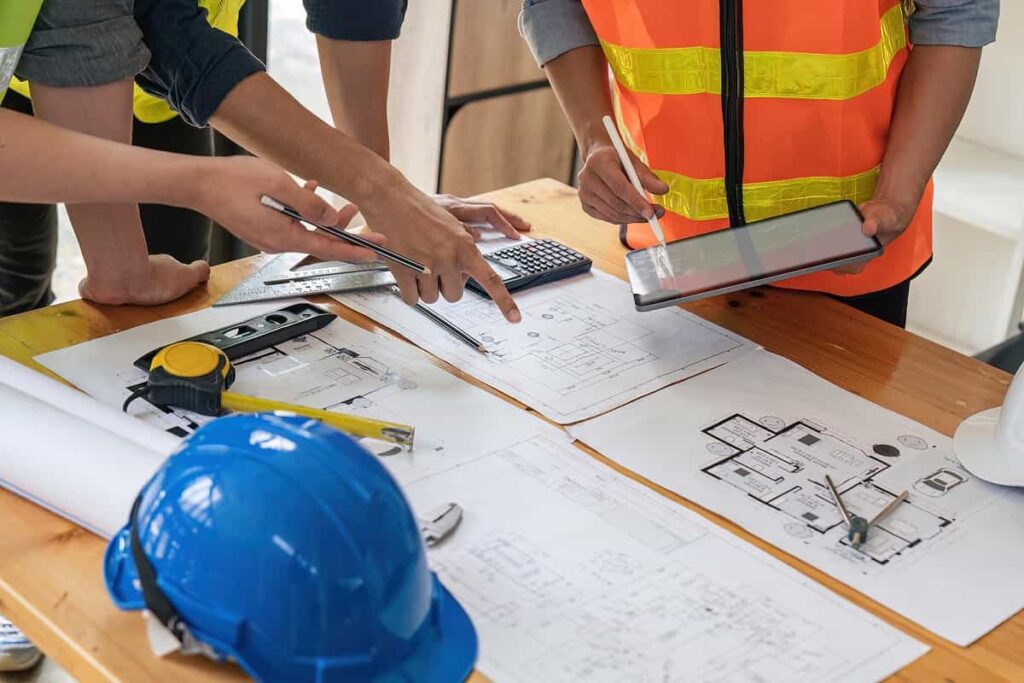These 3D Printed Houses Are Available Today
Table of contents

Our market research shows that an incredibly large number of you are interested in 3D printed houses. You want to know when they’ll be available, how much they’ll cost, and how big they can be built. It’s all rather unusual because we’re not sure what the appeal of 3D printed houses would be. Given the exorbitant real estate prices these days, maybe it’s the appeal of a cheaper method of manufacturing houses?
Around three years ago, we looked at 8 Startups Building Robotic Construction Workers, one of which was a firm called Cazza which offered the world a 3D rendering of a robot 3D printing a building.

That’s about as far as they got. Today, their website domain is up for sale for $20,000, presumably so they can return something to their investors who plowed $950,000 into the idea. (Equity crowdfunding zealots, take note.) On the plus side, several 3D printing construction startups have stepped in to fill the void. Before we get into all that, let’s answer the big question.
When Will 3D Printed Houses be Available?
The answer is today. A company called ICON procured a concrete 3D printer and worked with an award-winning designer to print some of the world’s first 3D printed houses that are available today to purchase. If you go to the following link – East 17th Street Residences – and wait 20 minutes for all the graphics to load, you’ll see these beautiful houses, some of which are still for sale. (We’d love to hear from anyone who has or will pull the trigger on one of these.) If you’re the type of person whose next question is, “how big can 3D houses be built?”, you probably don’t care too much about cost. (You lucky bastard.) For peasants like us, cost is a huge factor.
How Much do 3D Printed Houses Cost?
How long is a piece of string? The better question to ask here is, “are 3D printed houses more affordable than houses constructed using traditional construction methods?” If we look at ICON’s value proposition, it’s obvious that cost is not an initial selling point.
The Vulcan can produce resilient, single-story homes faster than conventional methods and with less waste and more design freedom.
The Vulcan
The Vulcan is a 9,500-pound robot that churns out cement structures on demand. ICON passed over the usual “cobot arm pouring crete” model and skipped right to a robot that doesn’t look like you might expect.

Vulcan can create structures faster than traditional methods, with less “wasted building materials,” and with a seemingly infinite number of configurations. Engineers like to talk about the three-legged stool – time, money, and quality. You can have two, but the other you need to sacrifice. If Vulcan can 3D print a 3,000 sq foot house in a quarter the time it takes tweakers extremely detail-oriented construction workers, then that’s going to come with a cost.
Pop quiz. Read the below statement and see if you can guess which income bracket a house like this might be targeted towards.
The first home in ICON’s Exploration Series, “House Zero,” is designed by the award-winning firm, Lake|Flato Architects and features an elevated architectural and energy efficient design that highlights the benefits of resiliency and sustainability only found in homebuilding through 3D printing.
Award-winning creators of mid-century modernist ranch house aesthetics don’t come with average price tags. Do they?
How to Get a 3D Printed House
We didn’t have the time to inquire as to the prices of ICON’s 3D printed houses, but luckily someone else did, and they were competent enough to include all the relevant information in a single paragraph we could copy-paste. (CTRL-C, CTRL-V.)
A new development in East Austin is selling four houses built using ICON’s technology, starting at $450,000 (roughly the median home price in Austin at present). To be clear, ICON 3D-printed the first floor of each of the two- to four-bedroom homes in the new East 17th Street Residences development; the upper floors were built using conventional construction. They’ll be ready for move-in this summer.
Credit: The Verge
So, one floor was built the traditional way, and one using 3D printing. Still, you’re getting “award winning design” and ultimate configurability for the same price as traditional construction methods with houses being constructed on demand in a weeks’ time. Where do we sign up? On their website, of course. Let’s take a closer look at the company making this happen by actually 3D printing the structures – ICON.
About ICON
Founded in 2017, Austin’s own ICON has taken in $266.5 million in disclosed funding to build “a construction technologies company using 3D robotics, software and advanced materials to revolutionize homebuilding.” A good chunk of that funding came in the form of a $207 million round that was announced just yesterday. Investors include Citibank and NASA, the latter which ICON seems to cater to by putting their space-related efforts front and center on their website. Being able to rapidly construct large shelters will come in handy when we land on Mars or the moon, two places that ICON talks about being suitable places to use their platform.
But for now, they’re focused on 3D printing buildings here on earth. To date, ICON has delivered more than two dozen 3D printed homes and structures across the U.S. and Mexico—more than any other construction tech company. What makes the whole thing possible is an advanced polymer concrete called LavaCrete.
LavaCrete vs. Concrete
Most houses use concrete for their foundations, but it’s not typical for an entire house to be built of concrete. (Over 90% of American homes are built using wood.) That’s because concrete is quite difficult to work with. It needs to be mixed, poured into molds, and then given plenty of time to cure. The secret sauce behind ICON’s 3D printed houses is an advanced polymer material called LavaCrete.
People who shower before going to work probably don’t know much about concrete. Those who shower after work probably know the basics of laying concrete. Second only to water, concrete is the most consumed material, with three tones per year used for every person in the world. If you pour a concrete driveway, it cures to about 70% strength in a week. That’s bog-standard concrete, but high-performance concrete is a whole different story.

The LavaCrete series of high-performance polymer concretes seen above can be applied and returned to service the same or next day and can cure at temperatures down to 40 degrees Fahrenheit. These products are all about speed of installation and chemical resistance. “Because of their quick cure times, these products are often used in food processing plants where return-to-service time is measured in hours,” said Tnemec, the company that makes the stuff. It’s a high-performance material that provides three times the bond of normal concrete with corrosion resistance embedded. In short, the advanced polymer concrete used by ICON is a critically important part of their value proposition.
LavaCrete Use Cases
The strongest performance characteristics of ICON’s platform are configurability and quick-drying concrete. What use cases might require constructing buildings quickly on demand using dynamic configurations? The military comes to mind, and ICON is dabbling there.

The real benefit of this platform is the speed at which it can build structures. Of course, being able to build a house in a week instead of several months is only a benefit if someone wants to buy it. That’s why it’s important for ICON 3D printed houses to look as appealing as traditional homes. And they certainly do from our perspective.

We’d like to see a detailed case study showing the benefits of having a house constructed using 3D printing so we can try to gauge what sort of genuine demand there might be on the consumer side aside from just personal curiosity which may be driving all this interest we’re seeing. ICON needs to show construction firms that money can be saved using Vulcan as opposed to traditional methods. Finally, they need to compare the “residential construction” value proposition to see if 3D printed houses are the way forward. Having some 3D printed houses still offered for sale makes us wonder just what demand is like for a completely new method of construction. Consumers may need some time to adjust. In the meantime, other use cases might prove to be more economically viable.
The Competition
ICON isn’t the only company dabbling in construction using 3d printing. A firm called Mighty Buildings is using 3D printing technology in a different manner. Their own 3D printed material and unique printing process is used to create panels at a central location and then they’re shipped to where the house is being built. The idea seems to have legs as the company has raised $101.8 million in disclosed funding so far from a whole slew of investors including notable venture capital firm Khosla and Alumni Ventures Group.

Is using 3D printed panels for modular construction considered a 3D printed building? Who knows, but if it helps reduce construction costs and aids with the affordable housing crisis, then that’s a good thing. The company says that’s their aim, but then we see stuff like this.
Our unique turnkey services using Mighty Kit System are starting at $339,000 and can be customized to your liking.
Credit: Mighty Buildings
3D printed structures were originally thought of as a way to solve the housing crisis by building affordable homes. That’s not the direction this whole thing appears to be taking, though ICON is involved in a project to print enough 3D printed habitats to house 40% of Austin’s homeless population. What’s clear is that the ideal 3D printed home may not be entirely constructed using additive manufacturing. The construction industry is one of the most technologically backwards industries around, and there are many ways traditional construction methods can be improved without the need for a 4.75 ton- concrete 3D printing robot. (We cover this in our recent piece on Procore – A Pure-Play Construction Tech Stock.)
Numerous companies are likely to be dabbling in 3d printed construction, and we may look to do a summary of them all in a later piece. If you want to be included, just drop the name of your sacred cow in the comments section below and we’ll see it makes the grade.
Conclusion
There’s a lot of banter among tech rags as to who built the first 3D printed house. We’d rather know about companies that build 3D printed houses you can buy today as opposed to one-off proof of concepts. The company under the spotlight right now is ICON, and their recent funding round and novel way of producing housing structures may prove to be a lucrative business, no matter what the ideal use case might be for quick-drying 3D printed concrete.
Sign up to our newsletter to get more of our great research delivered straight to your inbox!
Nanalyze Weekly includes useful insights written by our team of underpaid MBAs, research on new disruptive technology stocks flying under the radar, and summaries of our recent research. Always 100% free.

















Joe – How about 3-D printed MRIs? Mark
Hey Mark. Joe isn’t here right now. He’s off breaking company policy by entertaining clients at the local gentleman’s club.
Do you mean 3D printed magnetic resonance imaging machines? Or do you mean MREs, like the military rations? Or is there some MRI acronym we’re blissfully unaware of?
Looks like about 20% of the structure is “3D” printed. Hardly a 3D printed house. Also it appears that the 3D printed walls are low precision and with a probably poor R value. Lots of finish work to install windows, doors, plumbing… This approach is hardly a leap in technology. On the plus side they do provide protection from small arms fire!
After researching this piece and considering what’s on offer, we’d have to agree with you. There are plenty of other more interesting use cases for rapid drying cement. It would be interesting to see the deck ICON used to raise that $200 million.
FBR.AX – Australian stock for printed houses.
FBR Ltd (formerly Fastbrick Robotics Limited) (ASX:FBR) is a Perth based robotics company. FBR is the creator of Hadrian X, the world’s first fully automated end to end robotic bricklayer. In November 2016, Fastbrick Robotics won the Western Australian Innovator of the Year Award.
Yep, covered them: https://nanalyze.com/2017/11/robot-brickmasons-robotic-bricklaying/
No revenues, miniscule market cap, avoid like the plague.
I love reading some of the thoughts and replies on your articles. John Janiec’s thought on this article was great. I have been wondering hoe to protect myself against small arms fire. Also how to protect myself against high powered automatic assault weapons.
The best way to protect yourself against high-powered automatic assault weapons is to buy some high-powered automatic assault weapons.
Come on guys – Joe would have known what an MRI is. It’s a 2D representation of a 3D containing various elements. Same with MRA’s. Let’s have them printed – 3D (ability to dissamble of course). Million times easier to interpret.
MRE’s are Meals Ready to Eat! Some G.I.s you were
Ah yes. That could be a use case for 3DP.
G.I. Joe, G.I. Joe, fighting man from head to toe, on the land, on the sea, in the air.
In which states do they offer 3D printed homes currently?
Only Texas that we’re aware of. You would need to contact the Ministry of Truth, Google, beyond what we’ve already provided in this piece. Thank you!
I’d love to have a home. We live in Montana price for homes are outrageous with California coming in and shooting prices up
At least you don’t live in Idaho.
Would it be a consideration to put a mesh material in the walls to protect from EMPs? Also, how bug, termite resistant are the 3D homes? Thank you for your answers.
Good questions that are best posed directly to the company as we’re just a research firm.
My name is Lisa Kussler, I’m looking to get a 3D printing house made here in Franklin, NC. So I’m asking when will you be coming to Franklin, NC. I’m sure this will be the first here.
Please gat back to me soon thank you
Hey Lisa,
Best to reach out to the companies directly as we’re only a media/research firm.
Thank you!
Thank you for painting a realistic picture and saving my valuable time. I am about to build a house.
When I saw in the news about a 3D printed house completed by “habitat for humanity”, I thought it must be affordable for all ordinary folks like me so let me check out. But, according to your article, it is not worth of wasting my time.
From what we can tell, it seems like kind of a gimmick in its current manifestation for white picket fence applications. The houses we’ve talked about in this piece are quite different from what Habitat for Humanity might be doing. We’re actually not too well versed on this subject. It’s just that one of our MBAs thought it was a cool thing to look at. 🙂
I have three concerns: 1) Concrete is responsible for 10% of global Co2 ewmissions so it would seem to be the wrong growth industry for the current time period–unless you can explain more; 2) wouldn’t there be problem with Co2 accumulation indoors because concrete has no breathability–unlike normal wood structures. Have their been tests on Co2 accumulation?; what about other health concerns with living in what seems like a concrete tumbs–have interiors been tested for accumulations of other toxins?
You’re probably not going to like this answer but we really don’t care about any of that. We’re interested in knowing – as investors – whether 3D printed houses are economically viable. There are a bunch of firms working on “green concrete” but that’s a subject for another article.
I am looking to price a 3d 8feet wide, 20 feet long 12 feet high shed onto a 8x20x feet trailor.
We’re just a media firm Brenda. But if the price is right, we can swing some hammers for you.